An Analysis of the Biological Diversity of Saskatchewan, Canada
VerifiedAdded on 2020/04/15
|6
|1275
|43
Report
AI Summary
This report provides a comprehensive overview of the biological diversity of Saskatchewan, a province in Canada. It begins with an introduction to the geography of Saskatchewan, including its location, climate, and drainage systems. The report then delves into the various eco-regions, such as the boreal forest, prairie eco-zone, and the Canadian Shield, highlighting the unique flora and fauna found in each region. It discusses the diverse animal species, including the white-tailed deer, barren ground caribou, and various bird species. Furthermore, the report compares Saskatchewan's biodiversity to other regions of Canada and the world, emphasizing its unique ecosystem. The report also touches upon the population and land regions of Saskatchewan, including its ethnic groups, forest industry, and agricultural significance, as well as some interesting facts about the province, such as its mineral resources. The report concludes with a list of references used in its preparation.
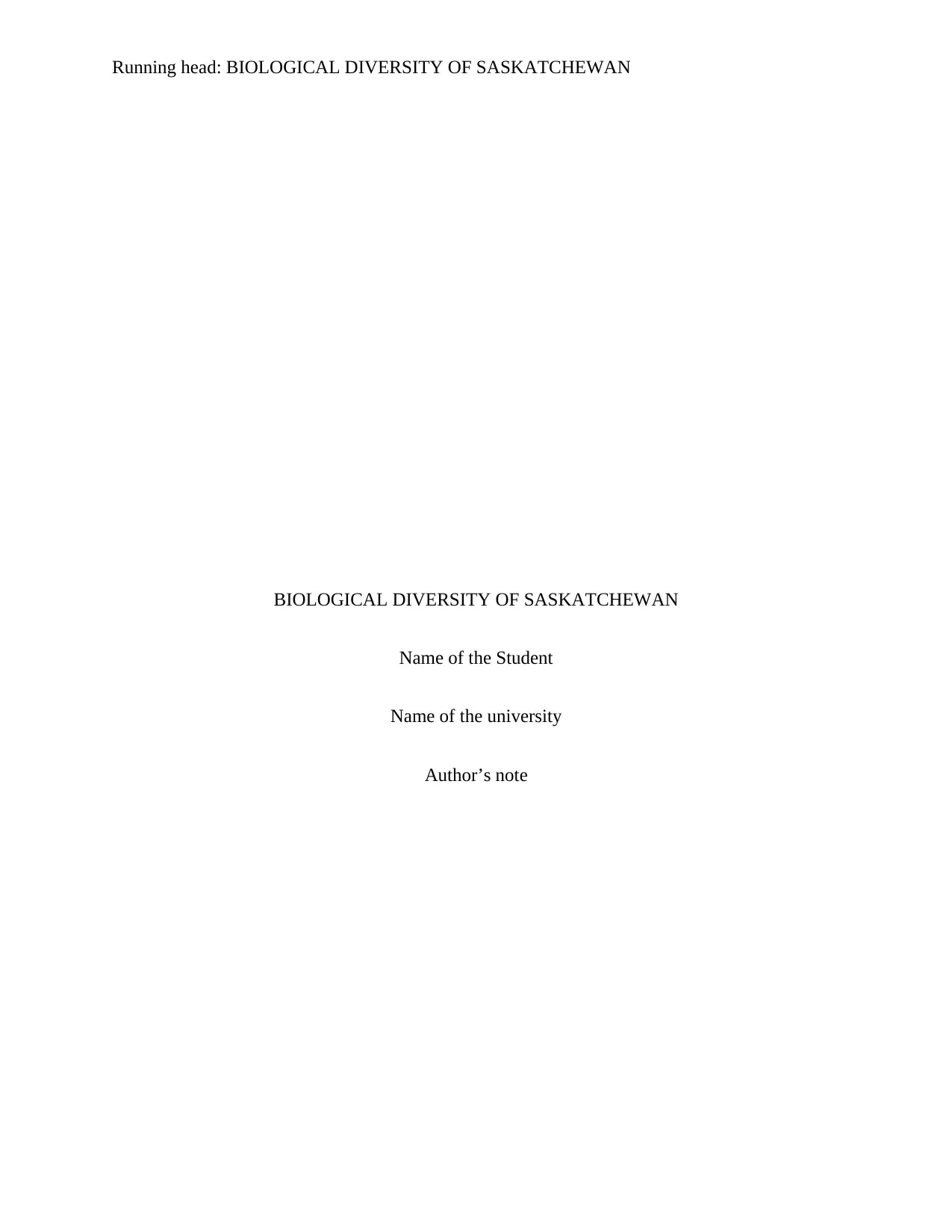
Running head: BIOLOGICAL DIVERSITY OF SASKATCHEWAN
BIOLOGICAL DIVERSITY OF SASKATCHEWAN
Name of the Student
Name of the university
Author’s note
BIOLOGICAL DIVERSITY OF SASKATCHEWAN
Name of the Student
Name of the university
Author’s note
Paraphrase This Document
Need a fresh take? Get an instant paraphrase of this document with our AI Paraphraser
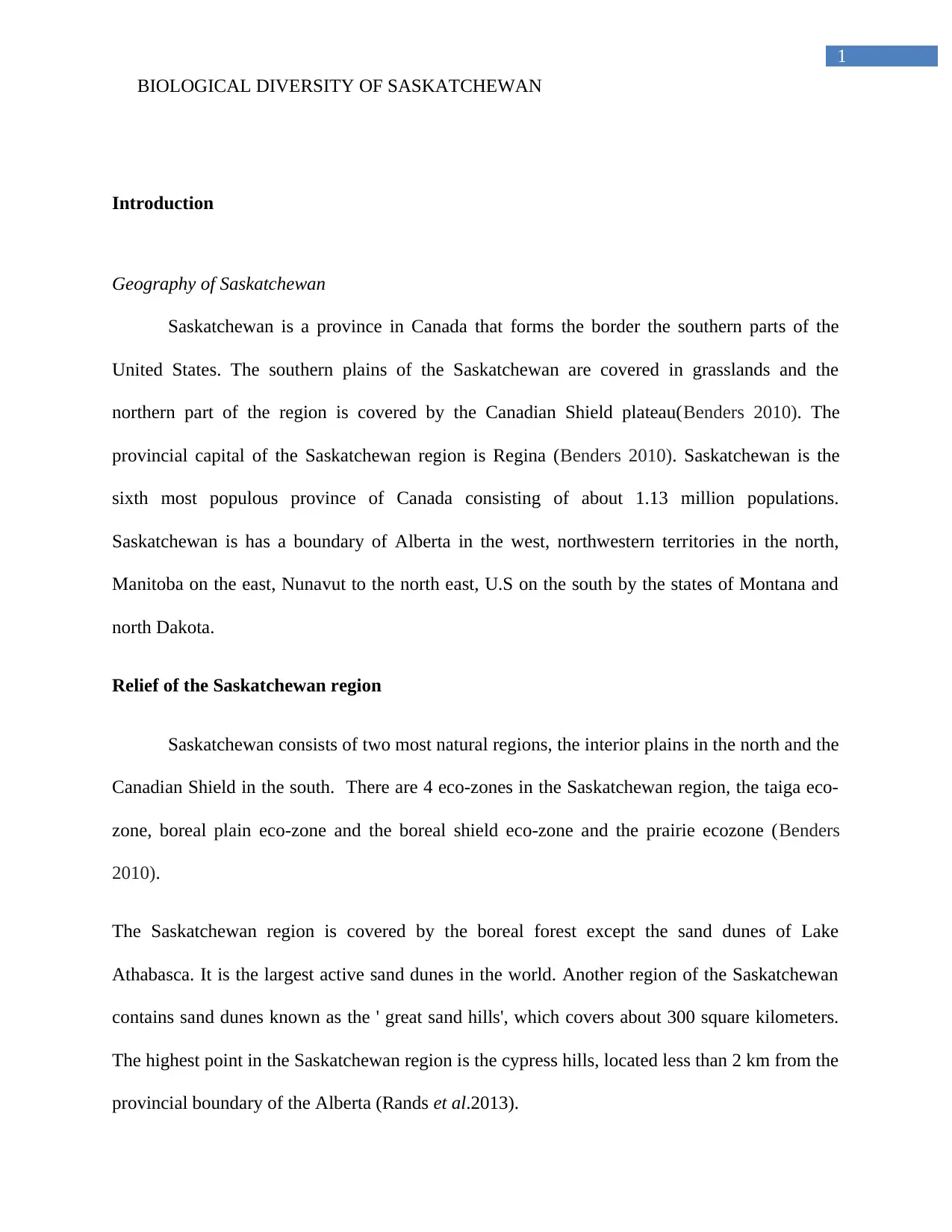
1
BIOLOGICAL DIVERSITY OF SASKATCHEWAN
Introduction
Geography of Saskatchewan
Saskatchewan is a province in Canada that forms the border the southern parts of the
United States. The southern plains of the Saskatchewan are covered in grasslands and the
northern part of the region is covered by the Canadian Shield plateau(Benders 2010). The
provincial capital of the Saskatchewan region is Regina (Benders 2010). Saskatchewan is the
sixth most populous province of Canada consisting of about 1.13 million populations.
Saskatchewan is has a boundary of Alberta in the west, northwestern territories in the north,
Manitoba on the east, Nunavut to the north east, U.S on the south by the states of Montana and
north Dakota.
Relief of the Saskatchewan region
Saskatchewan consists of two most natural regions, the interior plains in the north and the
Canadian Shield in the south. There are 4 eco-zones in the Saskatchewan region, the taiga eco-
zone, boreal plain eco-zone and the boreal shield eco-zone and the prairie ecozone (Benders
2010).
The Saskatchewan region is covered by the boreal forest except the sand dunes of Lake
Athabasca. It is the largest active sand dunes in the world. Another region of the Saskatchewan
contains sand dunes known as the ' great sand hills', which covers about 300 square kilometers.
The highest point in the Saskatchewan region is the cypress hills, located less than 2 km from the
provincial boundary of the Alberta (Rands et al.2013).
BIOLOGICAL DIVERSITY OF SASKATCHEWAN
Introduction
Geography of Saskatchewan
Saskatchewan is a province in Canada that forms the border the southern parts of the
United States. The southern plains of the Saskatchewan are covered in grasslands and the
northern part of the region is covered by the Canadian Shield plateau(Benders 2010). The
provincial capital of the Saskatchewan region is Regina (Benders 2010). Saskatchewan is the
sixth most populous province of Canada consisting of about 1.13 million populations.
Saskatchewan is has a boundary of Alberta in the west, northwestern territories in the north,
Manitoba on the east, Nunavut to the north east, U.S on the south by the states of Montana and
north Dakota.
Relief of the Saskatchewan region
Saskatchewan consists of two most natural regions, the interior plains in the north and the
Canadian Shield in the south. There are 4 eco-zones in the Saskatchewan region, the taiga eco-
zone, boreal plain eco-zone and the boreal shield eco-zone and the prairie ecozone (Benders
2010).
The Saskatchewan region is covered by the boreal forest except the sand dunes of Lake
Athabasca. It is the largest active sand dunes in the world. Another region of the Saskatchewan
contains sand dunes known as the ' great sand hills', which covers about 300 square kilometers.
The highest point in the Saskatchewan region is the cypress hills, located less than 2 km from the
provincial boundary of the Alberta (Rands et al.2013).
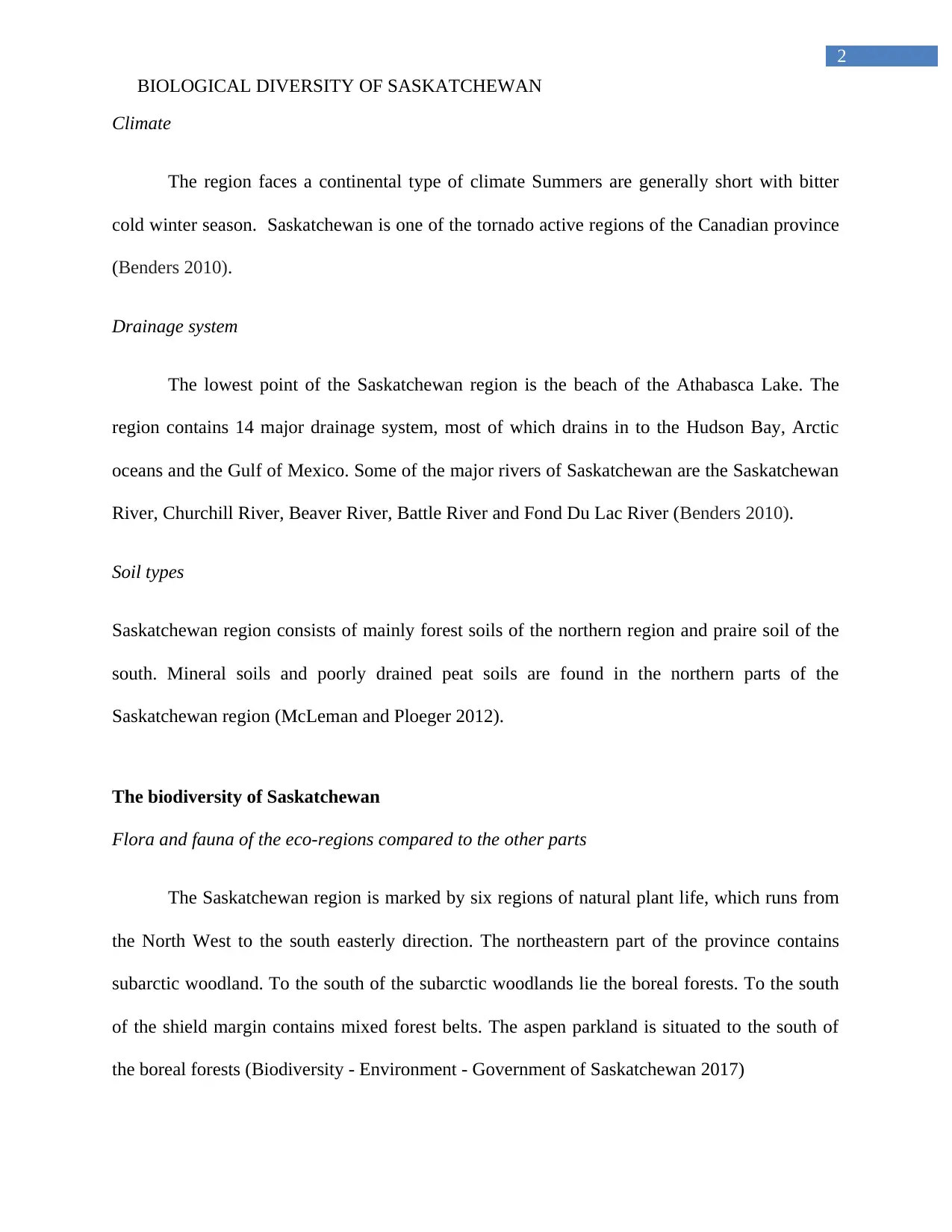
2
BIOLOGICAL DIVERSITY OF SASKATCHEWAN
Climate
The region faces a continental type of climate Summers are generally short with bitter
cold winter season. Saskatchewan is one of the tornado active regions of the Canadian province
(Benders 2010).
Drainage system
The lowest point of the Saskatchewan region is the beach of the Athabasca Lake. The
region contains 14 major drainage system, most of which drains in to the Hudson Bay, Arctic
oceans and the Gulf of Mexico. Some of the major rivers of Saskatchewan are the Saskatchewan
River, Churchill River, Beaver River, Battle River and Fond Du Lac River (Benders 2010).
Soil types
Saskatchewan region consists of mainly forest soils of the northern region and praire soil of the
south. Mineral soils and poorly drained peat soils are found in the northern parts of the
Saskatchewan region (McLeman and Ploeger 2012).
The biodiversity of Saskatchewan
Flora and fauna of the eco-regions compared to the other parts
The Saskatchewan region is marked by six regions of natural plant life, which runs from
the North West to the south easterly direction. The northeastern part of the province contains
subarctic woodland. To the south of the subarctic woodlands lie the boreal forests. To the south
of the shield margin contains mixed forest belts. The aspen parkland is situated to the south of
the boreal forests (Biodiversity - Environment - Government of Saskatchewan 2017)
BIOLOGICAL DIVERSITY OF SASKATCHEWAN
Climate
The region faces a continental type of climate Summers are generally short with bitter
cold winter season. Saskatchewan is one of the tornado active regions of the Canadian province
(Benders 2010).
Drainage system
The lowest point of the Saskatchewan region is the beach of the Athabasca Lake. The
region contains 14 major drainage system, most of which drains in to the Hudson Bay, Arctic
oceans and the Gulf of Mexico. Some of the major rivers of Saskatchewan are the Saskatchewan
River, Churchill River, Beaver River, Battle River and Fond Du Lac River (Benders 2010).
Soil types
Saskatchewan region consists of mainly forest soils of the northern region and praire soil of the
south. Mineral soils and poorly drained peat soils are found in the northern parts of the
Saskatchewan region (McLeman and Ploeger 2012).
The biodiversity of Saskatchewan
Flora and fauna of the eco-regions compared to the other parts
The Saskatchewan region is marked by six regions of natural plant life, which runs from
the North West to the south easterly direction. The northeastern part of the province contains
subarctic woodland. To the south of the subarctic woodlands lie the boreal forests. To the south
of the shield margin contains mixed forest belts. The aspen parkland is situated to the south of
the boreal forests (Biodiversity - Environment - Government of Saskatchewan 2017)
⊘ This is a preview!⊘
Do you want full access?
Subscribe today to unlock all pages.

Trusted by 1+ million students worldwide
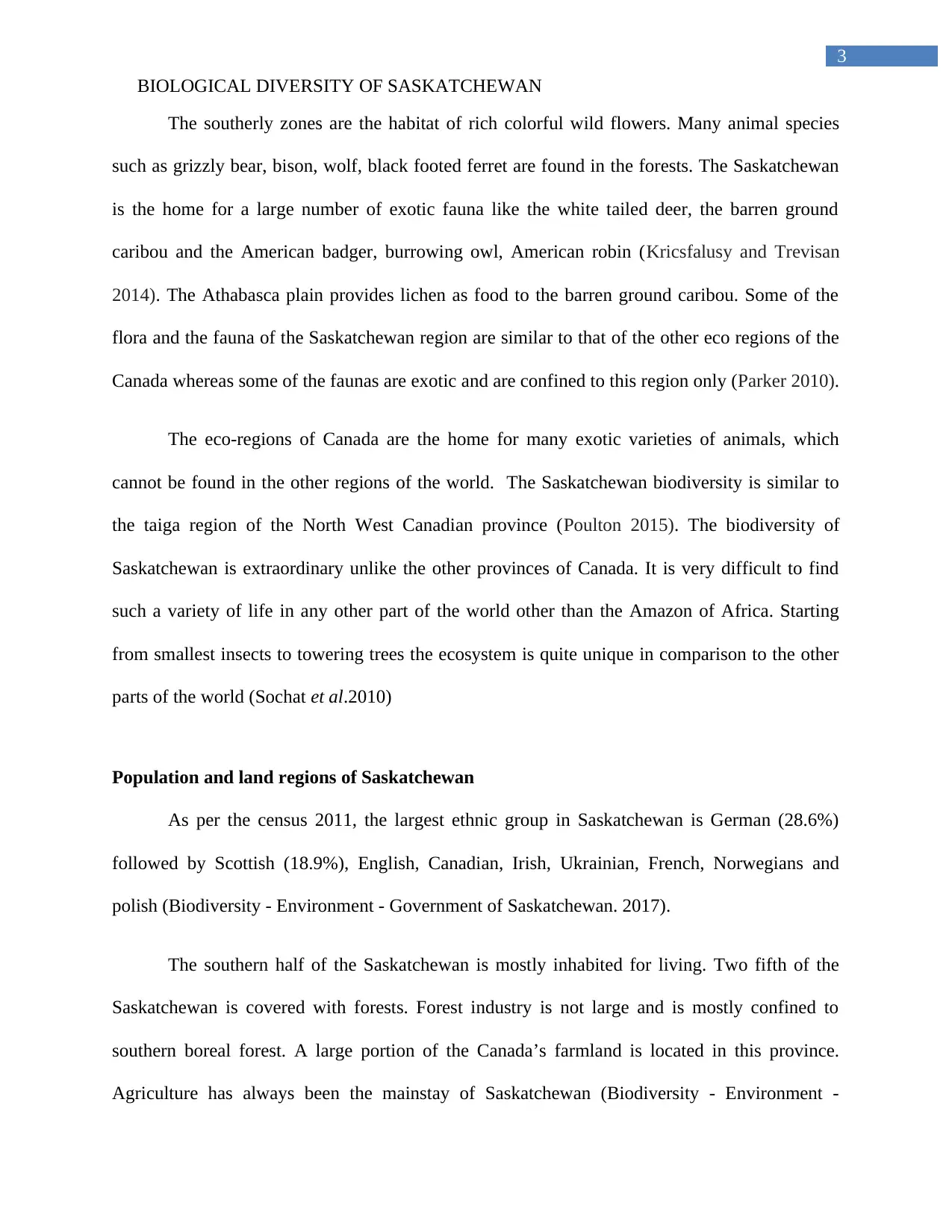
3
BIOLOGICAL DIVERSITY OF SASKATCHEWAN
The southerly zones are the habitat of rich colorful wild flowers. Many animal species
such as grizzly bear, bison, wolf, black footed ferret are found in the forests. The Saskatchewan
is the home for a large number of exotic fauna like the white tailed deer, the barren ground
caribou and the American badger, burrowing owl, American robin (Kricsfalusy and Trevisan
2014). The Athabasca plain provides lichen as food to the barren ground caribou. Some of the
flora and the fauna of the Saskatchewan region are similar to that of the other eco regions of the
Canada whereas some of the faunas are exotic and are confined to this region only (Parker 2010).
The eco-regions of Canada are the home for many exotic varieties of animals, which
cannot be found in the other regions of the world. The Saskatchewan biodiversity is similar to
the taiga region of the North West Canadian province (Poulton 2015). The biodiversity of
Saskatchewan is extraordinary unlike the other provinces of Canada. It is very difficult to find
such a variety of life in any other part of the world other than the Amazon of Africa. Starting
from smallest insects to towering trees the ecosystem is quite unique in comparison to the other
parts of the world (Sochat et al.2010)
Population and land regions of Saskatchewan
As per the census 2011, the largest ethnic group in Saskatchewan is German (28.6%)
followed by Scottish (18.9%), English, Canadian, Irish, Ukrainian, French, Norwegians and
polish (Biodiversity - Environment - Government of Saskatchewan. 2017).
The southern half of the Saskatchewan is mostly inhabited for living. Two fifth of the
Saskatchewan is covered with forests. Forest industry is not large and is mostly confined to
southern boreal forest. A large portion of the Canada’s farmland is located in this province.
Agriculture has always been the mainstay of Saskatchewan (Biodiversity - Environment -
BIOLOGICAL DIVERSITY OF SASKATCHEWAN
The southerly zones are the habitat of rich colorful wild flowers. Many animal species
such as grizzly bear, bison, wolf, black footed ferret are found in the forests. The Saskatchewan
is the home for a large number of exotic fauna like the white tailed deer, the barren ground
caribou and the American badger, burrowing owl, American robin (Kricsfalusy and Trevisan
2014). The Athabasca plain provides lichen as food to the barren ground caribou. Some of the
flora and the fauna of the Saskatchewan region are similar to that of the other eco regions of the
Canada whereas some of the faunas are exotic and are confined to this region only (Parker 2010).
The eco-regions of Canada are the home for many exotic varieties of animals, which
cannot be found in the other regions of the world. The Saskatchewan biodiversity is similar to
the taiga region of the North West Canadian province (Poulton 2015). The biodiversity of
Saskatchewan is extraordinary unlike the other provinces of Canada. It is very difficult to find
such a variety of life in any other part of the world other than the Amazon of Africa. Starting
from smallest insects to towering trees the ecosystem is quite unique in comparison to the other
parts of the world (Sochat et al.2010)
Population and land regions of Saskatchewan
As per the census 2011, the largest ethnic group in Saskatchewan is German (28.6%)
followed by Scottish (18.9%), English, Canadian, Irish, Ukrainian, French, Norwegians and
polish (Biodiversity - Environment - Government of Saskatchewan. 2017).
The southern half of the Saskatchewan is mostly inhabited for living. Two fifth of the
Saskatchewan is covered with forests. Forest industry is not large and is mostly confined to
southern boreal forest. A large portion of the Canada’s farmland is located in this province.
Agriculture has always been the mainstay of Saskatchewan (Biodiversity - Environment -
Paraphrase This Document
Need a fresh take? Get an instant paraphrase of this document with our AI Paraphraser
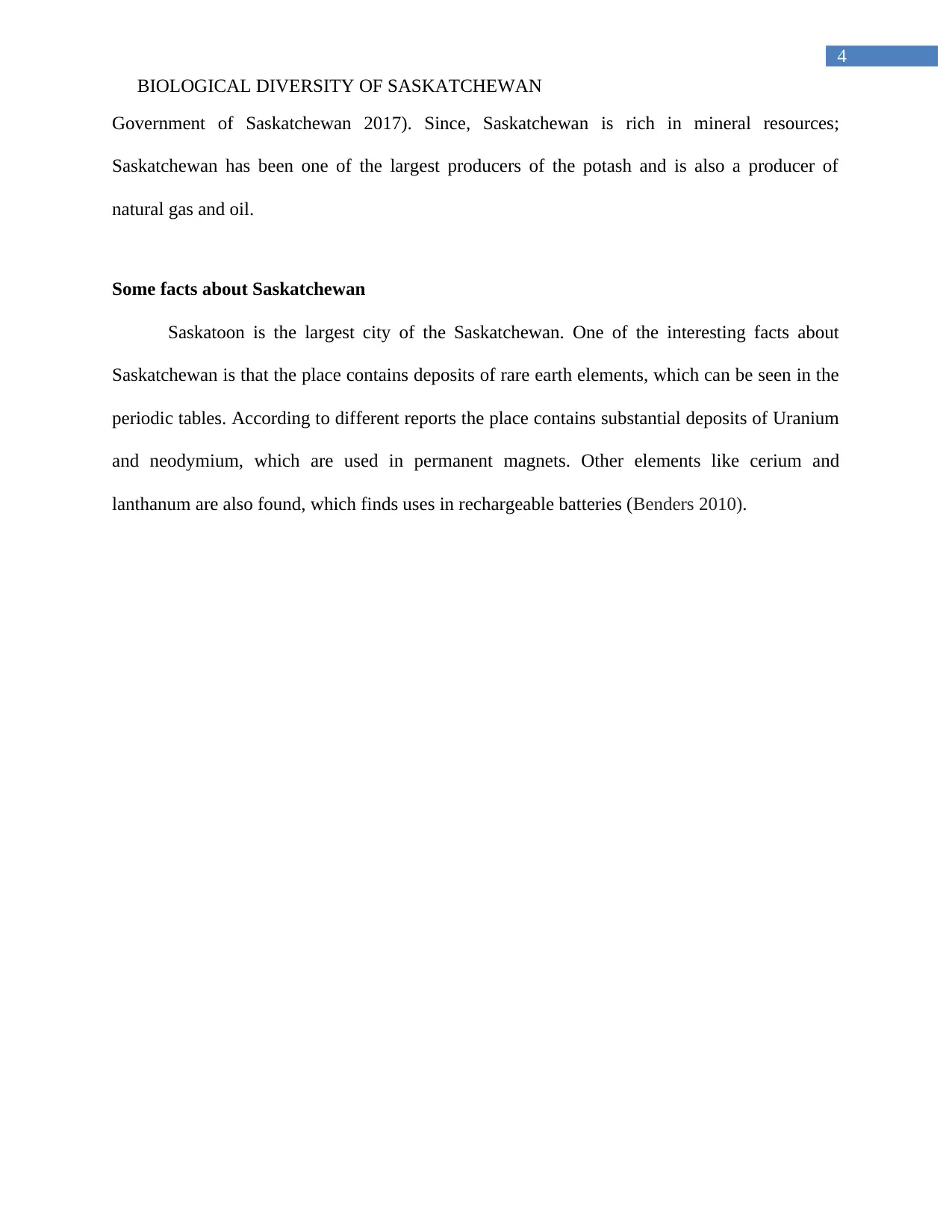
4
BIOLOGICAL DIVERSITY OF SASKATCHEWAN
Government of Saskatchewan 2017). Since, Saskatchewan is rich in mineral resources;
Saskatchewan has been one of the largest producers of the potash and is also a producer of
natural gas and oil.
Some facts about Saskatchewan
Saskatoon is the largest city of the Saskatchewan. One of the interesting facts about
Saskatchewan is that the place contains deposits of rare earth elements, which can be seen in the
periodic tables. According to different reports the place contains substantial deposits of Uranium
and neodymium, which are used in permanent magnets. Other elements like cerium and
lanthanum are also found, which finds uses in rechargeable batteries (Benders 2010).
BIOLOGICAL DIVERSITY OF SASKATCHEWAN
Government of Saskatchewan 2017). Since, Saskatchewan is rich in mineral resources;
Saskatchewan has been one of the largest producers of the potash and is also a producer of
natural gas and oil.
Some facts about Saskatchewan
Saskatoon is the largest city of the Saskatchewan. One of the interesting facts about
Saskatchewan is that the place contains deposits of rare earth elements, which can be seen in the
periodic tables. According to different reports the place contains substantial deposits of Uranium
and neodymium, which are used in permanent magnets. Other elements like cerium and
lanthanum are also found, which finds uses in rechargeable batteries (Benders 2010).
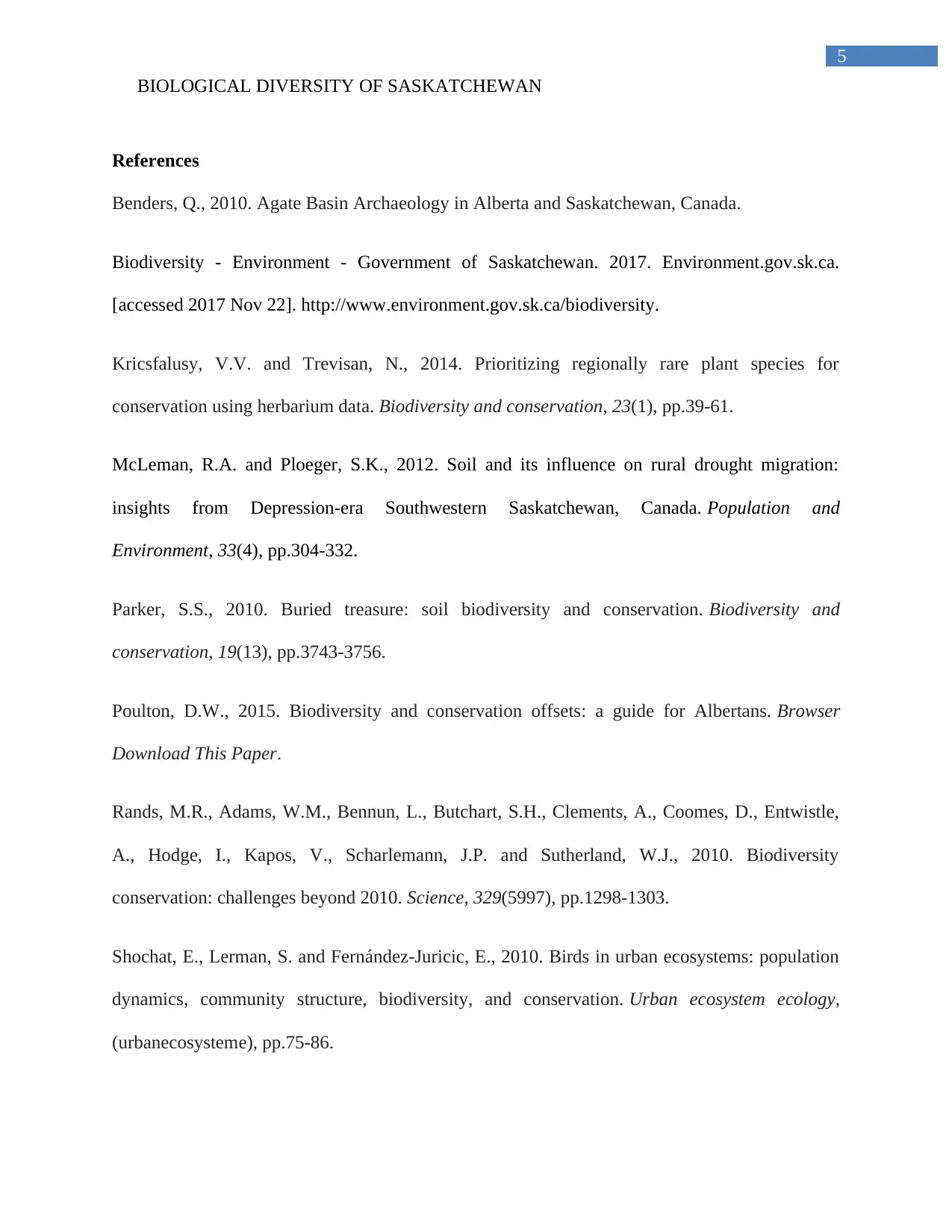
5
BIOLOGICAL DIVERSITY OF SASKATCHEWAN
References
Benders, Q., 2010. Agate Basin Archaeology in Alberta and Saskatchewan, Canada.
Biodiversity - Environment - Government of Saskatchewan. 2017. Environment.gov.sk.ca.
[accessed 2017 Nov 22]. http://www.environment.gov.sk.ca/biodiversity.
Kricsfalusy, V.V. and Trevisan, N., 2014. Prioritizing regionally rare plant species for
conservation using herbarium data. Biodiversity and conservation, 23(1), pp.39-61.
McLeman, R.A. and Ploeger, S.K., 2012. Soil and its influence on rural drought migration:
insights from Depression-era Southwestern Saskatchewan, Canada. Population and
Environment, 33(4), pp.304-332.
Parker, S.S., 2010. Buried treasure: soil biodiversity and conservation. Biodiversity and
conservation, 19(13), pp.3743-3756.
Poulton, D.W., 2015. Biodiversity and conservation offsets: a guide for Albertans. Browser
Download This Paper.
Rands, M.R., Adams, W.M., Bennun, L., Butchart, S.H., Clements, A., Coomes, D., Entwistle,
A., Hodge, I., Kapos, V., Scharlemann, J.P. and Sutherland, W.J., 2010. Biodiversity
conservation: challenges beyond 2010. Science, 329(5997), pp.1298-1303.
Shochat, E., Lerman, S. and Fernández-Juricic, E., 2010. Birds in urban ecosystems: population
dynamics, community structure, biodiversity, and conservation. Urban ecosystem ecology,
(urbanecosysteme), pp.75-86.
BIOLOGICAL DIVERSITY OF SASKATCHEWAN
References
Benders, Q., 2010. Agate Basin Archaeology in Alberta and Saskatchewan, Canada.
Biodiversity - Environment - Government of Saskatchewan. 2017. Environment.gov.sk.ca.
[accessed 2017 Nov 22]. http://www.environment.gov.sk.ca/biodiversity.
Kricsfalusy, V.V. and Trevisan, N., 2014. Prioritizing regionally rare plant species for
conservation using herbarium data. Biodiversity and conservation, 23(1), pp.39-61.
McLeman, R.A. and Ploeger, S.K., 2012. Soil and its influence on rural drought migration:
insights from Depression-era Southwestern Saskatchewan, Canada. Population and
Environment, 33(4), pp.304-332.
Parker, S.S., 2010. Buried treasure: soil biodiversity and conservation. Biodiversity and
conservation, 19(13), pp.3743-3756.
Poulton, D.W., 2015. Biodiversity and conservation offsets: a guide for Albertans. Browser
Download This Paper.
Rands, M.R., Adams, W.M., Bennun, L., Butchart, S.H., Clements, A., Coomes, D., Entwistle,
A., Hodge, I., Kapos, V., Scharlemann, J.P. and Sutherland, W.J., 2010. Biodiversity
conservation: challenges beyond 2010. Science, 329(5997), pp.1298-1303.
Shochat, E., Lerman, S. and Fernández-Juricic, E., 2010. Birds in urban ecosystems: population
dynamics, community structure, biodiversity, and conservation. Urban ecosystem ecology,
(urbanecosysteme), pp.75-86.
⊘ This is a preview!⊘
Do you want full access?
Subscribe today to unlock all pages.

Trusted by 1+ million students worldwide
1 out of 6
Your All-in-One AI-Powered Toolkit for Academic Success.
+13062052269
info@desklib.com
Available 24*7 on WhatsApp / Email
![[object Object]](/_next/static/media/star-bottom.7253800d.svg)
Unlock your academic potential
Copyright © 2020–2025 A2Z Services. All Rights Reserved. Developed and managed by ZUCOL.